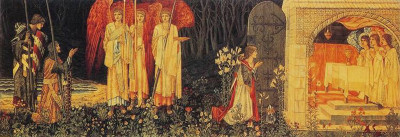The Story of the Holy Grail was a series of tapestries designed by Edward Burne Jones and woven by William Morris & Co in the late 19th century.
The Vision refers to the final piece in this series and is sometimes known by the longer name of The Attainment: The Vision of the Holy Grail to Sir Galahad, Sir Bors, and Sir Perceval or The Achievement of the Grail or The Achievement of Sir Galahad. This entire project was commissioned by William Knox D'Arcy in 1890 and the tapestries were intended to be used within his dining room. The artworks were well received and were indeed installed within the patron's home at Stanmore Hill, leading to Morris & Co choosing to produce further versions of these tapestries at a later date. Although we include these designs within the career of William Morris, many other artists were also involved in their creation. The company would regularly collaborate in order to make use of the breadth of skills that existed within it, rather than trying to teach every artist how to cover each and every medium. That said, Morris would tend to try out pretty much every discipline by the end of his career, and was able to learn their specific techniques fairly quickly. We do know that Edward Burne-Jones took the design lead within this project and that Morris' involvement was more to do with the production phase.
The Birmingham Museum & Art Gallery hosts this delightful final piece, although that might be an iteration from a later version of the same series. Alongside the role of Burne-Jones and Morris, it is also believed that John Henry Dearle helped out on some of the decorative elements of the design, such as the flowers which spread across the bottom of the piece. The composition features a large number of figures spread across a horizontal layout, with an open door leading into a small placeof worship to the right hand side. Many elements of medieval British design can be found here, and the medium of tapestry gives the series a really traditional value. Aside from the detail given with trees at the back and flowers near by, there is also a sea which sweeps in from the left hand side, plus a number of soldiers who pray in the direction of the winged angels on the far side. The six items within this series would follow a similar style in order to provide a consistent look when placed together within the same dining room.
hostsThe Vision of the Holy Grail specifically features a small chapel and refers to how only a few knights could find it, even thought 150 had attempted. Essentially, the closer one could get, then the purer their character, with one individual managing to get all the way to the open door. This is believed to be Sir Galahad and he is joined by lilies which specifically represent purity. Many more references to Christian themes are represented within this elaborate final part of the series and it would prove a popular set of designs by this highly regarded company. They believed in continuing traditional artistic techniques rather than going for mass production which was becoming more and more common during the late 19th century, and sadly many of their ideas have fallen into obscurity over time.




